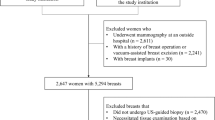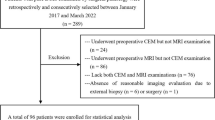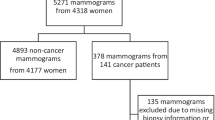Abstract
Objectives
To assess the costs and health-related outcomes of double versus single reading of digital mammograms in a breast cancer screening programme.
Methods
Based on data from 57,157 digital screening mammograms from women aged 50–69 years, we compared costs, false-positive results, positive predictive value and cancer detection rate using four reading strategies: double reading with and without consensus and arbitration, and single reading with first reader only and second reader only. Four highly trained radiologists read the mammograms.
Results
Double reading with consensus and arbitration was 15 % (Euro 334,341) more expensive than single reading with first reader only. False-positive results were more frequent at double reading with consensus and arbitration than at single reading with first reader only (4.5 % and 4.2 %, respectively; p < 0.001). The positive predictive value (9.3 % and 9.1 %; p = 0.812) and cancer detection rate were similar for both reading strategies (4.6 and 4.2 per 1000 screens; p = 0.283).
Conclusions
Our results suggest that changing to single reading of mammograms could produce savings in breast cancer screening. Single reading could reduce the frequency of false-positive results without changing the cancer detection rate. These results are not conclusive and cannot be generalized to other contexts with less trained radiologists.
Key Points
• Double reading of digital mammograms is more expensive than single reading.
• Compared to single reading, double reading yields a higher proportion of false-positive results.
• The cancer detection rate was similar for double and single readings.
• Single reading may be a cost-effective strategy in breast cancer screening programmes.

Similar content being viewed by others
Abbreviations
- DCIS:
-
Ductal carcinoma in situ.
References
Broeders M, Moss S, Nyström L et al (2012) The impact of mammographic screening on breast cancer mortality in Europe: a review of observational studies. J Med Screen 19:14–25
The Independent UK Panel on Breast Cancer Screening (2012) The benefits and harms of breast cancer screening: an independent review. Lancet 380:1778–1786
European Commission. Perry N, Broeders M, de Wolf C, et al. (2006) European Guidelines for Quality Assurance in Breast Cancer Screening and Diagnosis, 4th edn. Office for Official Publications of the European Communities, Luxembourg
Gøtzsche PC, Jørgensen KJ (2013) Screening for breast cancer with mammography. Cochrane Database Syst Rev. doi:10.1002/14651858
Biller-Andorno N, Jüni P (2014) Abolishing Mammography Screening Programs? A View from the Swiss Medical Board. N Engl J Med 370:1965–1967
Jørgensen KJ (2013) Mammography screening. Benefits, harms, and informed choice 60:B4614
Paci E, Broeders M, Hofvind S, Puliti D, Duffy SW, EUROSCREEN Working Group (2014) European breast cancer service screening outcomes: a first balance sheet of the benefits and harms. Cancer Epidemiol Biomarkers Prev 23:1159–1163
World Health Organisation WHO (2002) International Agency for Research on Cancer. Breast cancer screening. World Health Organization, Geneva. Available via: http://www.iarc.fr/en/publications/pdfs-online/prev/handbook7/Handbook7_Breast-5.pdf. Accessed 26 Jul 2015.
Bond M, Pavey T, Welch K et al (2013) Systematic review of the psychological consequences of false-positive screening mammograms. Health Technol Assess. doi:10.3310/hta17130
Dinnes J, Moss S, Melia J, Blanks R, Song F, Kleijnen J (2001) Effectiveness and cost-effectiveness of double reading of mammograms in breast cancer screening: findings of a systematic review. Breast 10:455–463
Taylor P, Potts HW (2008) Computer aids and human second reading as interventions in screening mammography: two systematic reviews to compare effects on cancer detection and recall rate. Eur J Cancer 44:798–807
van den Biggelaar F, Kessels A, van Engelshoven J, Flobbe K (2009) Strategies for digital mammography interpretation in a clinical patient population. Int J Cancer 125:2923–2929
Román R, Sala M, Salas D et al (2012) Effect of protocol-related variables and women's characteristics on the cumulative false-positive risk in breast cancer screening. Ann Oncol 23:104–111
Taplin SH, Rutter CM, Elmore JG, Seger D, White D, Brenner RJ (2000) Accuracy of screening mammography using single versus independent double interpretation. AJR Am J Roentgenol 174:1257–1262
Shaw CM, Flanagan FL, Fenlon HM, McNicholas MM (2009) Consensus review of discordant findings maximizes cancer detection rate in double-reader screening mammography: Irish National Breast Screening Program experience. Radiology 250:354–362
Duijm LEM, Groenewoud JH, Hendriks JHCL, de Koning HJ (2004) Independent double reading of screening mammograms in The Netherlands: effect of arbitration following reader disagreements. Radiology 231:564–570
Hofvind S, Geller BM, Rosenberg RD, Skaane P (2009) Screening-detected breast cancers: discordant independent double reading in a population-based screening program. Radiology 253:652–660
Klompenhouwer EG, Voogd AC, den Heeten GJ et al (2015) Discrepant screening mammography assessments at blinded and non-blinded double reading: impact of arbitration by a third reader on screening outcome. Eur Radiol 25:2821–2829
Gray AM, Clarke PM, Wolstenholme JL, Wordsworth S (2010) Applied Methods of Cost-effectiveness Analysis in Healthcare, 1st ed. Oxford University Press
Chubak J, Boudreau DM, Fishman PA, Elmore JG (2010) Cost of Breast-Related Care in the Year Following False Positive Screening Mammograms. Med Care 48:815–820
Payne JI, Martin T, Caines JS, Duggan R (2014) The Burden of False-Positive Results in Analog and Digital Screening Mammography: Experience of the Nova Scotia Breast Screening Program. Can Assoc Radiol J 65:315–320
Sala M, Domingo L, Macià F et al (2015) Does digital mammography suppose an advance in early diagnosis? Trends in performance indicators 6 years after digitalization. Eur Radiol 25:850–859
Leivo T, Salminen T, Sintonen H et al (1999) Incremental cost-effectiveness of double-reading mammograms. Breast Cancer Res Treat 54:261–267
Ciatto S, Del Turco MR, Morrone D et al (1995) Independent double reading of screening mammograms. J Med Screen 2:99–101
Seradour B, Wait S, Jacquemier J, Dubuc M, Piana L (1997) Double reading of mammograms in the Bouches-du-Rhone screening programme. Results and costs, 1990–1995. J Radiol 78:49–54
Brown J, Bryan S, Warren R (1996) Mammography screening: an incremental cost effectiveness analysis of double versus single reading of mammograms. BMJ 312:809–812
Ciatto S, Ambrogetti D, Bonardi R et al (2005) Second reading of screening mammograms increases cancer detection and recall rates Results in the Florence screening programme. J Med Screen 12:103–106
Pauli R, Hammond S, Cooke J, Ansell J (1996) Comparison of radiographer/radiologist double film reading with single reading in breast cancer screening. J Med Screen 3:18–22
Taplin S, Abraham L, Barlow WE et al (2008) Mammography facility characteristics associated with interpretive accuracy of screening mammography. J Natl Cancer Inst 100:876–887
Ripping TM, Verbeek ALM, Fracheboud J, de Koning HJ, van Ravesteyn NT, Broeders MJM (2015) Overdiagnosis by mammographic screening for breast cancer studied in birth cohorts in The Netherlands. Int J Cancer 137:921–929
Acknowledgements
The scientific guarantor of this publication is Margarita C. Posso Rivera. The authors of this manuscript declare no relationships with any companies, whose products or services may be related to the subject matter of the article. The authors state that this work has not received any funding. No complex statistical methods were necessary for this paper. Institutional Review Board approval was obtained. Written informed consent was waived by the Institutional Review Board. Methodology: retrospective, cross sectional study, performed at one institution.
Author information
Authors and Affiliations
Corresponding author
Additional information
Margarita C. Posso is a Ph.D. candidate at the Methodology of Biomedical Research and Public Health program Universitat Autònoma de Barcelona (UAB), Barcelona, Spain.
Rights and permissions
About this article
Cite this article
Posso, M.C., Puig, T., Quintana, M.J. et al. Double versus single reading of mammograms in a breast cancer screening programme: a cost-consequence analysis. Eur Radiol 26, 3262–3271 (2016). https://doi.org/10.1007/s00330-015-4175-4
Received:
Revised:
Accepted:
Published:
Issue Date:
DOI: https://doi.org/10.1007/s00330-015-4175-4




